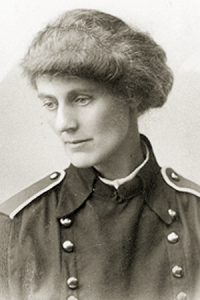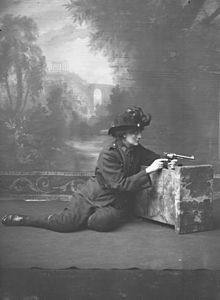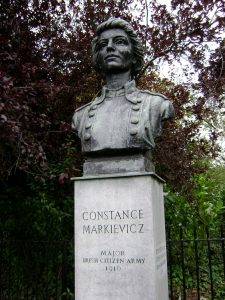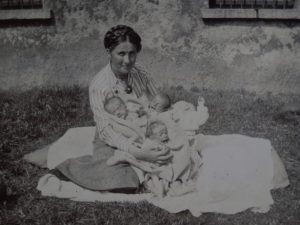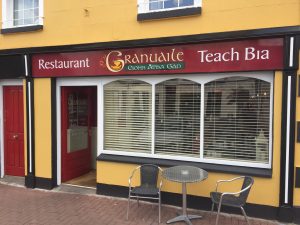Most women, between the poverty and the relentless child-bearing, didn’t have much of a chance to make their mark on Irish history in any way apart from the family tree. Not that Ireland was unique in that regard. There were some, though, generally from the upper classes, who had the time and sometimes the education – or just the sheer bloody-mindedness – to make their way into the history books, the museums, the exhibits at interpretative centres and the school curriculum. Over the last year a few names have popped up on my radar from time to time and I think they’re all worth a mention here.
The one you really can’t miss, especially around the centenary of the Easter Rising, is the Countess Markievicz.
She was born Constance Gore-Booth in 1868 and acquired the fancy foreign name when she married a Polish guy who may or may not have been a legitimate Count. She was a suffragist and a patron of the arts and, after hanging around with revolutionaries, she launched herself into nationalist politics. She joined Sinn Féin and the revolutionary women’s movement Inghinidhe na hÉireann and, in 1909, co-founded a paramilitary version of the Boy Scouts to teach teenage boys to use firearms. Just, you know, in case. Nothing to see here.
The Countess was jailed for the first time in 1911 during a protest against a visit by the English king, George V, to Ireland. She had been throwing stones at pictures of the king and queen, burning the British flag and generally engaging in non-loyal-British-subject activities. During the 1913 Dublin lock-out when 20,000 workers who went on strike for better pay and conditions, and the right to form unions, were denied work for seven months she supported them publicly and ran soup kitchens for their families. To keep providing food she took out loans and sold her jewellery.
Then came the 1916 Rising and she kicked it up a notch by shooting a policeman and a British Army sniper within, like, the first ten minutes. Well, the first day, anyway. She was based in St Stephen’s Green in the centre of Dublin and was in the midst of all the action. When surrender came she was the only one of 70 women arrested to be kept in solitary confinement, presumably because she was considered the most dangerous. Along with the other leaders she was sentenced to death, but was given a reprieve solely on the basis of being a woman, a decision she responded to by telling her British captors, ‘I do wish your lot had the decency to shoot me.’
In 1917 she was released from prison as part of an amnesty and in 1918 she was elected as a TD (MP) for Dublin with Sinn Féin, making her the first woman ever elected to the British House of Commons, not that she went. Apart from anything else (like Sinn Féin’s policy of saying ‘thanks but no thanks’ to seats in British parliament) she was in prison again at the time, for seditious speech. From 1919 to 1922 the Countess was Minister for Labour and she remained the only female cabinet minister in Ireland until 1979. She fought again for the Republican cause in the Civil War in 1922 and was imprisoned again, eventually being released after joining 92 other women in a hunger strike.
Having given away the last of her wealth, Countess Markievicz died of appendicitis in 1927 in a public hospital ward among the poor. She was refused a state funeral – probably on the grounds of having been too much of a handful – but was given a funeral oration by the head of the government of the new Free State, Éamon de Valera.
There were plenty of women fighting for the Republican cause, plenty involved in the labour and suffrage movements, plenty of female philanthropists, and they all deserve recognition. The Countess stands out for her absolute dedication, her toughness, her general take-no-prisoners attitude. She was described by friends as ‘wildly flamboyant’. Her fashion advice to young women of the time? ‘Dress suitably in short skirts and strong boots, leave your jewels in the bank and buy a revolver.’ See what I mean? Hard-core.
Unlike many women at the time, the Countess had choices. She was born into the aristocracy and the Church of Ireland – the ruling Protestant class – which meant that she could have lived in comfort and luxury, enjoying her place in high society in London or Paris or anywhere, if she’d wanted. But she didn’t. She got down and dirty with the oppressed and the disenfranchised. She peeled potatoes in the soup kitchens for impoverished children, she got blood on her hands in the Rebellion, she went to jail for her beliefs again and again. It appears that she wasn’t afraid of anything.
In Ireland there’s a Markievicz Park, House, Road, Leisure Centre and probably more. There’s a statue of her in the Leisure Centre and a bust in St Stephen’s Green. And now – greatest honour of all – she’s immortalised here on my blog.
While the Countess was dying in hospital she was tended by, among others, Dr Kathleen Lynn. Dr Lynn was not only a suffragist, nationalist, activist and politician, like her friend the Countess, but a medical doctor as well. I need a lie down just thinking about all that.
Kathleen left school at 16 determined to become a doctor because she’d seen so much suffering resulting from the famines. She was one of the first female medical graduates from the University College, Dublin and was the very first female doctor to work at the Royal Victoria Eye and Ear Hospital. Eyes and ears weren’t her passion, though. Poor people were.
In 1919 Dr Lynn, with a group of like-minded female activists, founded St Ultan’s Children’s Hospital. Mothers and babies in the inner city were dying in huge numbers and St Ultan’s was her effort to help. There women and children were provided with food, medical care, tuberculosis vaccinations and education. Because Dr Lynn had experienced plenty of gender discrimination in her career St Ultan’s was the only hospital in Ireland managed entirely by women. It was in operation until 1987.
So far, so relatively respectable. Probably at cocktail parties she didn’t go into too much detail about the fact that quite a few of the health needs of the women and children she dealt with were caused by the estimated 15,000 soldiers who had returned from World War One with syphilis. While her buddy the Countess was shooting snipers during the Rising, what was Dr Lynn doing?
She was running guns, that’s what. Who’s going to stop a respectable lady doctor and search her car? She kept the arms in her house. When the shooting started, as the chief medical officer for the revolutionaries she was right there at City Hall up to the elbows in gore and dying men. She was arrested and sent to Kilmainham Gaol where she kept a detailed diary on tiny scraps of paper. She writes of lice, rats, typhus, of hearing the executions of her colleagues, of the despair of other women as their brothers and fiancées were shot, and of being disowned by her own family.
After her release from prison Dr Lynn became vice-president of the Sinn Féin executive, and she became a TD for Dublin in 1923. She carried on writing diaries until her death in 1955 and these give a valuable insight into the early decades of the Free State from the perspective of a woman whose dream was an Ireland free of British rule and of all forms of oppression. The diaries are now on display at the Royal College of Physicians. She was buried with full military honours.
She is described as one of the great humanitarians of 20th century Irish history and also, by the minister at her funeral no less, as an unpleasant and mean woman. Make of that what you will. For 30 years she lived with her BFF and fellow activist Madeleine ffrench-Mullen – make of that what you will too. Like the Countess Markievicz, Kathleen Lynn was born into a well-off Protestant family and could have had a nice comfortable life, but she didn’t choose to. She chose to risk her life for the Republican cause, to spend her time with the poorest of the poor, and to stand well outside the lines of conventional, appropriate behaviour for women of the time. I’ve seen a documentary about her life and none of it was easy. Being taken seriously as a medical professional in a man’s world, having her concerns about the health of people who were, after all, only poor women and children heard and acted on, continuing on her path even though her family were so ashamed that they would have nothing to do with her – it was a big deal. She probably had to be mean and unpleasant to achieve a quarter of what she wanted to. You don’t get this stuff done by being the simpering, swooning type.
Which brings me to Grace O’Malley (Gráinne Ní Mháille), the pirate queen of Connacht. She wasn’t simpering or swooning. She was swashbuckling.
Even in a list of hard-core women this one stands out. She was high-born and inherited a large chunk of the west of Ireland from her mother along with a fleet of ships from her father. Her first marriage was a strategic match of powerful families and when her husband died she added to her wealth and was said to own 1,000 head of cattle and horses – real rich-list stuff in the 1500’s. Inheriting the land and money was one thing; it was the power she gained and held on to that sets her apart.
The O’Malleys controlled the coastal area around Galway in the west. Her father called himself a businessman but it was piracy that paid the bills. He, and later Grace, used the fleet to intercept trading ships and relieve them of money and cargo before letting them on their way. They also visited the outlying islands of Scotland on the way home from trading missions and raided them. Grace started learning the ropes of the international shipping trade very young and, according to legend, cut all her hair off as a girl because her father had refused to let her join him on a voyage to Spain on the grounds that the long hair would get caught up in the ropes. This embarrassed him into letting her go, and earned her the nickname Granuaile, pronounced Gronya-whale (‘Bald Grace’).
Grace’s first husband, Dónal an Chogaidh Ó Flaithbheartaigh, heir to the O’Flaherty title, was expected to one day rule the area now known as Connemara. When he died, Grace took his place and did it instead. She now controlled a large area with many castles and was constantly under attack by the English as well as other Irish clans. Dónal was killed in an ambush by an enemy clan and Grace took a shipwrecked sailor as her new lover. He was also killed and by now she’d had enough of that sort of carry-on and attacked the castle of the MacMahons (the baddies in this episode) and killed her lover’s murderers.
Very soon afterwards Grace married again. The new husband came with more land and within a year she’d kicked him to the curb while holding onto his castle by the simple means of occupying it and refusing to leave. The castle, Rockfleet, is still in the ownership of the O’Malley family today.
By this point Grace, head of both the O’Malley and the O’Flaherty clans, commanded a large number of fighting men and used them to attack ships and castles all over the place, as well as defending her own territory. She also offered 200 soldiers to serve English interests in Ireland and Scotland, in an attempt to gain some brownie points. The Irish lords had previously been more or less left to self-govern but towards the end of the 16th century the English were steadily taking over. In 1593 Grace’s half-brother and two sons were taken captive by the English Governor of Connacht and Grace went to England to ask the Queen for their release. Grace, pirate queen of the west, could speak Latin – of course she could – and as she didn’t speak English and Queen Elizabeth didn’t speak Irish the meeting was conducted in Latin. Grace refused to bow before the Queen because she didn’t recognise her as the queen of Ireland and she turned up with a dagger concealed about her person. Despite this they seem to have got along quite well, and the Queen agreed to have the captives released and to remove the governor who had taken them, on the condition that Grace stopped supporting the Irish lords’ rebellions. Although they parted as BFFs, the governor was soon returned to his post and carried on as before, so Grace realised that nothing had really been accomplished and went back to supporting the Irish insurgents. Grace was by now in her sixties, and probably died at Rockfleet Castle in 1703.
By all accounts Grace was as tough as they come. She held the loyalty of hundreds of men in her service, and was feared by many more. In those lawless times I imagine it was hard enough for anyone to keep a good grip on their land and power, let alone a woman and mother of four legitimate children and possibly one slightly less so. You had to be ruthless, and Grace was all over that. On one occasion in 1576 she was in the neighbourhood of Howth Castle in Dublin and decided to pop in for a catch-up with the Earl. She was told that the family were at dinner and unavailable, which is why you should always ring first. So she did what any reasonable person would do and kidnapped the Earl’s grandson. The Earl came around to her way of thinking and promised that the castle gates would always be open to unexpected visitors and a spare place would be set at every meal, and she gave the grandson back. To back up his pledge the Earl gave her a ring, which is still owned by one of her descendants, and the custom of setting an extra place is still honoured at Howth Castle. Which might come in handy next time I forget to make tea.
Granuaile has been the subject of many songs, plays, poems and books. She’s the sort of figure that captures the imagination. Like the Countess Markievicz she was a hell-raiser in a man’s world. She’d be an interesting dinner party guest.
You know how every now and then you get these weird coincidences? Like, you’ve never heard of a particular thing then suddenly it turns up three times in a row in different contexts? This one time a couple of years ago, for example, Daniel wanted a pogo stick for his birthday and none of the local shops stocked them (what are Farmlands and RD1 thinking?) so I looked online. There were a few options and I ordered one from a toy shop that I’d never heard of, but that came well reviewed and offered free delivery. Then the very next day I was looking on the Herald website and as I scrolled past the Business section, which I never read, the name of that same toyshop popped out at me in a story about how just that morning they’d gone into liquidation and called the receivers in. I mean, what are the chances?
Anyway, last weekend Josh and I were driving through Co. Longford (or it might have been Roscommon or Westmeath – they’re fairly similar) and to fill in the time I was telling him about my new hero, Grace O’Malley, who he’d never heard of. Then it was time for lunch (well, 3:30 – we’d had all-you-can-eat buffet breakfast only seven hours earlier) and he Googled for somewhere to eat, seeing as we were in completely unfamiliar territory. And what came up? This place:
the Granuaile Café in Kinnegad, Co. Westmeath. So we stopped and went in and the walls were decorated with pictures and stories of Grace O’Malley, pirate queen of Connacht. The owner’s name is Gráinne – Grace – and I guess Granuaile is her hero too. The food was excellent and I’m sure the pirate queen would be very proud.

